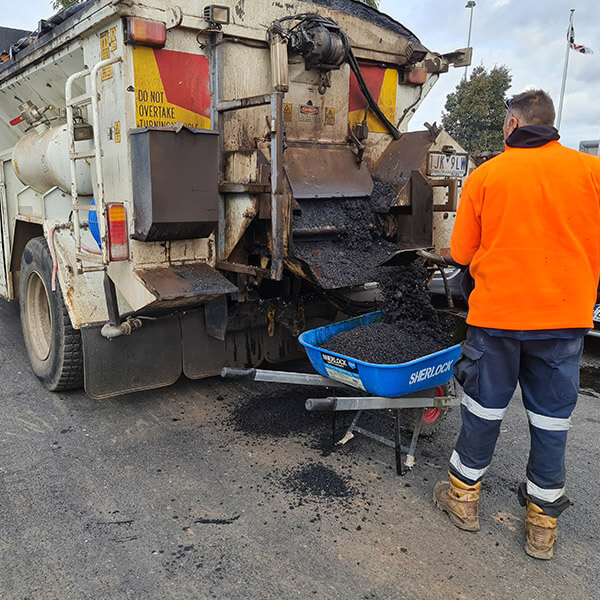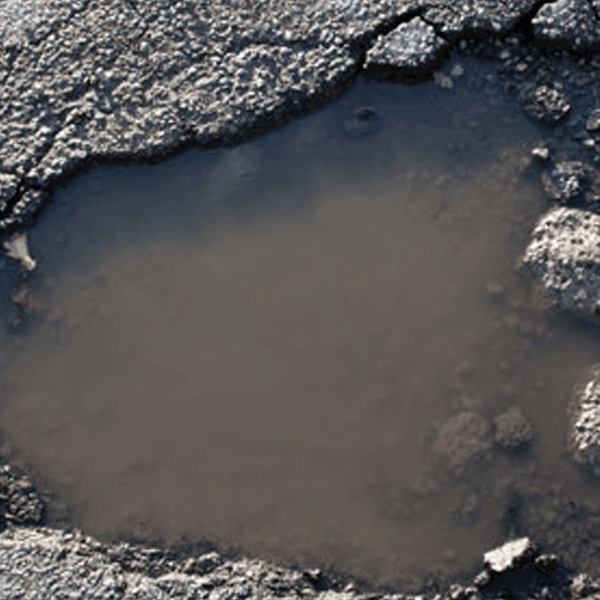Asphalt Driveways & Pathways
An attractive entrance is a valuable and functional asset. Asphalt drives and pathways are attractive and can be combined with features such as brick or concrete edging to give shape, form and colour. They can follow natural curves and ground shape, blending in harmony with gardens and lawns. Asphalt driveways and paths are also durable and economical. The following information has been prepared by the Australian Asphalt Pavement Association (AAPA) as a guide to assist you to obtain a quality asphalt driveway at a reasonable cost. It gives an overview of construction and design issues that will help you when you contact an AAPA member to design and lay your new drive or pathway
Design
Asphalt is a great medium for drives and pathways allowing flexibility in shape and form. It is also a smooth, non-slip surface that is easy to maintain. The use of complementary materials such as brick or concrete edging can also add character to an entrance as well as protecting gardens and lawns.

Brick edging can also be used to tie the house with the pathway by selecting a paver that compliments the colour of the house. Drives and paths may be straight, providing smooth access. Alternatively they may be curved to enhance the shape of a garden or to avoid trees and other features. Pathways and drives may also be linked providing convenient access to both vehicles and pedestrians. Asphalt drives and pathways may meander to reduce the steepness of slopes, to allow for vegetation to provide screening of doorways or garage doors. Whether straight or curved, asphalt driveways must be designed to ensure appropriate drainage and to ensure no pooling of water. Where driveways are curved these must ensure that vehicles can readily manoeuvre, taking into account the topography, vegetation and drainage. One advantage of asphalt paving over other materials is that changes can be made to the alignment by taking up part of an existing surface and adding new asphalt to another section. Damage to a surface can also be repaired. Asphalt is attractive, durable and economical and is the most flexible surface for all driveway and pathway requirements. Home owners should therefore work with their architect or asphalt contractor to design a driveway that is both attractive and functional.
Site Preparation
Site preparation is a key to ensuring a long life for any drive or pathway surface. Lack of preparation will lead to failure. Therefore make sure your contractor prepares the site taking into account the proposed use of the surface.
For example a driveway must have a solid base. Placing bitumen or asphalt on an unprepared sub-base will fail. However, a pathway will not require the same depth of sub-base material as a driveway. A driveway that frequently has heavy trucks will also need a stronger sub-base. For new driveways, the area to be paved must be stripped of any vegetation and topsoil. The underlying soil or rock should then be removed to a sufficient depth to ensure a stable base. The depth of material that must be removed will be determined by your asphalt contractor. Contractors would usually place a layer of crushed rock on the stable base to give a solid surface for the asphalt. However, in a few cases where the natural base is solid a contractor may be able to place the asphalt directly on that surface. A full depth asphalt surface may also be used where the there is already a firm stable base. However, simply spraying bitumen on an unstable sub-base will lead to immediate failure. For existing gravel driveways, the depth and quality of the existing material must be assessed prior to surfacing with asphalt. Where the depth is sufficient there may be no need to add additional base but this will depend on the thickness of the gravel and the base on which it is laid. In some cases where the depth of crushed rock cannot be increased or the quality is unacceptable, the existing material may need to be removed and replaced.

Drainage
Like site preparation, effective drainage is essential for any drive or pathway. Drainage will ensure that water cannot damage the surface by eroding away the sub-base or causing soils to expand. If soils are allowed to be eroded away or expand they will allow the pavement to crack or collapse. Effective drainage will also prevent any pooling or flooding of areas of pavement or at the end of paved areas. Your architect or asphalt contractor should identify any drainage issues and ensure they are addressed in the final design. To achieve effective drainage contractors must ensure the surface on which the asphalt is to be placed is graded and compacted to a smooth, free-draining even slope, free of depressions.
Where an asphalt driveway is to be constructed across sloping ground, the use of both surface and sub-surface drains on the uphill side will help control the flow of surface and sub-surface water, which, if not controlled, can cause softening and weakening of the sub-base.

For driveways constructed parallel to a slope, a grated drain should be placed across the driveway at the bottom of the slope or at the junction with adjacent surfaces (e.g. garage floor, footpath). In all cases the finished asphalt surface should be sloped at least at 1 in 60, without depressions, to provide for surface water runoff.
Asphalt Thickness

Asphalt should be laid by a professional asphalt contractor. However, for the general information of property owners the following information is provided on the construction of asphalt pavements. This should be taken as a guide although an individual contractor may need to make some changes to take into account the particular circumstances and site condition. Property owners should be aware that there are some unscrupulous contractors who will offer cheap paving, often claiming that it is left over material from other jobs and then put a totally unusable surface. So although the following is only a guide it may be used to check that your contractor is doing an appropriate job.
Typical pavement thicknesses for residential driveways that have normal vehicle traffic including 4WD vehicles require an asphalt thickness of 25mm provided it is placed over properly prepared sub-base material of 100mm thickness. For full depth asphalt, where the natural sub-base is solid the asphalt thickness should be at least 75mm. For driveways which are subjected to regular use by heavier vehicles (exceeding 3 tonnes gross weight), specific pavement engineering advice should be obtained.
Construction Sequence
For all asphalt paving jobs it is essential that a contractor or a competent supervisor is on site during the whole process. This person will ensure that the following steps are taken and that the work once completed will give a long lasting pavement that will enhance the value and look of your property.
- vegetation and topsoil cleared
- drains, installed as necessary
- and tree roots that may impact on the surface are checked for and appropriate action taken
- Site excavated to the required depth to ensure that all soft and unsuitable materials are removed
- weed killer applied if required
- subgrade compacted to a smooth, free draining, even slope. Note a Granular base material should be moist when placed and compacted and should be compacted with a pedestrian or ride-on vibrating roller.
- edges of driveway formed with a concrete, masonry or timber edging
- roadbase materials placed and compacted to provide an even hard surface of the correct thickness
- bitumen emulsion sprayed on surface to provide a strong bond
- hot-mix asphalt placed and compacted to ensure a smooth surface with the appropriate drainage slope with no potential to pool water. Note: Asphalt should be spread and compacted whilst hot – typically at a temperature above 90ºC. It should generally not be laid in cool, windy weather, as thin layers of asphalt cool very quickly in such conditions and it is difficult to achieve proper compaction and durability.
Coloured Asphalt and Edging
Coloured asphalt can be used to enhance a drive or pathway. Colours such as red and brown are relatively easy to obtain. Other colours may require the use of a special bitumen. Aggregate of a compatible colour should be used in the asphalt; as aggregate forms about 92–94% of the asphalt, a dark coloured aggregate (e.g. basalt) will dominate the colour of the asphalt once the bitumen wears off the surface of the aggregate. Your asphalt contractor will be able to discuss with you potential coloured asphalt. Edging is important to support the edge of asphalt.
It may be concrete, brick or timber and the range of colours, textures and materials allows for a wide choice of finish. Edging should typically be least 300mm wide to support the pavement edge. Such edging also leads to improved compaction of the edges of the asphalt surfacing.

Quotations & Price
Roadseal Bitumen Services will always offer competitive prices. However, as with all major investments it is recommended that property owners obtain written quotations with complete details of compacted thicknesses of layers, material types, quantities, areas and special requirements. This will show that the asphalt contractor has assessed your needs, taking into account the particular requirements of your property. It is often worthwhile asking the contractor to give you details of previous work and if possible you should also establish the past performance of the contractor you accept and remember the cheapest price won’t necessarily produce the best outcome.

Resurfacing Existing Driveways
One of the advantages of an asphalt drive or pathway is that it can be readily resurfaced if it is damaged. Renewal of the surface can also be accomplished rapidly and economically with minimum interference. Resurfacing with asphalt should be carried out by an asphalt contractor. The contractor will firstly assess the condition and strength of the surface to ensure that it is suitable for applying a new surface. The contractor will also assess any drainage issues and check for damage caused by roots from nearby trees. Any grass or weeds that have grown through the existing surface will also be destroyed prior to resurfacing. Once the surface is ready for recoating a coat of bitumen emulsion (a tack coat) is applied and before a new surface of hot asphalt is laid and compacted. Should the surface be badly damaged and especially if the sub-base is not stable then additional work may be necessary to restore a pavement.
Warning about unscrupulous contractors
Unfortunately there are some unscrupulous individuals who periodically operate in Australia offering cheap asphalt work. They call on unsuspecting people and advise that they have some material left over from a larger job and will do a driveway, pathway or carpark cheaply for cash. These people look very professional and appear to have the appropriate equipment but then put a thin layer of bitumen over unprepared ground, lay some stones on it and advise people not to use it until the bitumen has set.

They then demand payment in cash and disappear very quickly. These pavements usually fail immediately they are used. Always check that your contractors are following the procedures in this brochure and particularly that they are preparing the sub-base and applying material of an appropriate thickness. Remember – if it seems too cheap to be true, then it probably is. If you are approached by these people do not accept their offer. Asphalt and bitumen that is too thin will fail as will pavements laid on an unstable or unprepared base.
Congratulations on Your New Pavement
Once your drive or pathway is completed you will have an attractive durable and economical pavement that will add considerable value to your property. You will also be able to enjoy it for many, many years.




